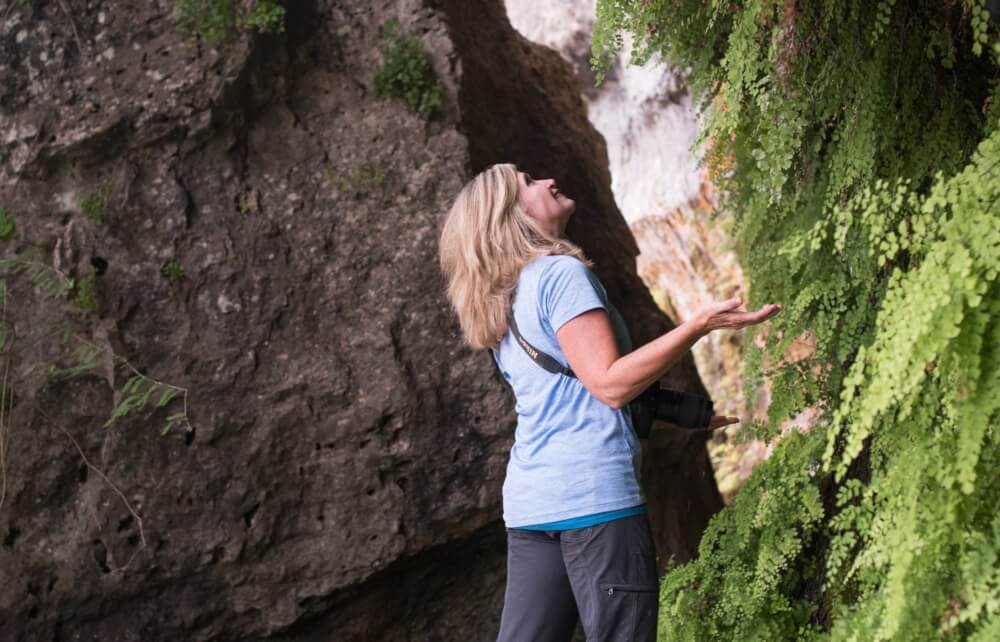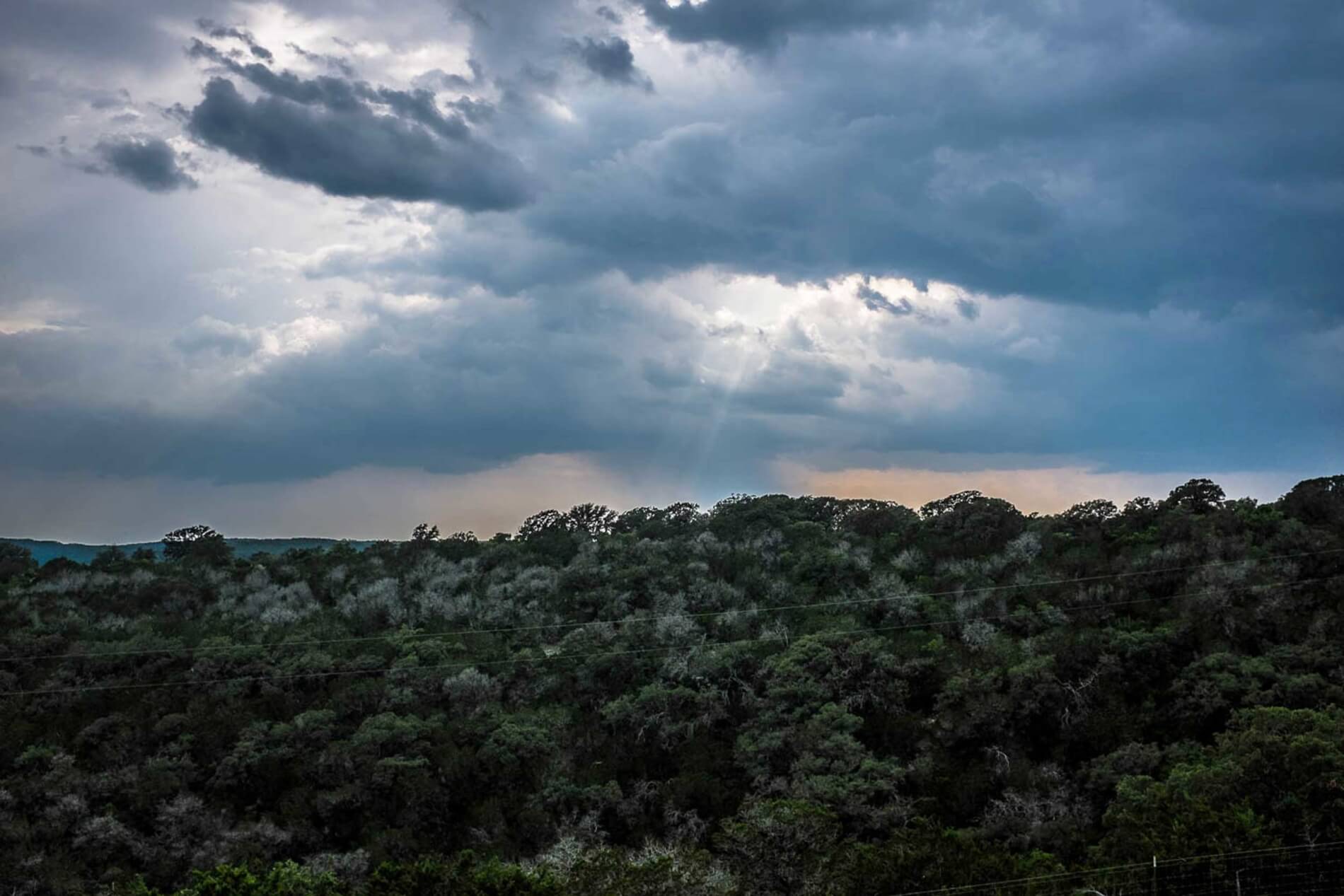

The Frio Canyon has played a significant role in Drukker’s life for more than 15 years. Her children went to Laity Lodge Youth Camp, she and her husband have frequented the Quiet House, and she is also a passionate volunteer surveyor of plant and animal species in the Canyon.
A certified Texas Master Naturalist, Drukker proudly reports every rare and endemic plant she finds at the Canyon—the scarlet leather flower, the Boerne bear, the big red sage. Whether Drukker is talking about little snails and invertebrates, rare fens along the river bank, or grass-like sedges, her voice has the same passion and enthusiasm.
“I’m excited every time I go out there,” Drukker says, “because I’m transported to another place and time, the slowness of life, the beauty and the quiet. I am fascinated by nature and discovering what God created.”
The Foundation has long been committed to caring for the Canyon. When the Butt family purchased the ranch in 1954, they were determined that the land would be protected even as Foundation programs grew and more and more people were invited to experience the Frio River Canyon. Today, David and Deborah Rogers are leading initiatives to ensure that the Canyon flourishes—that its environmental health is strengthened—in years to come.
“I’m excited every time I go out there because I’m transported to another place and time, the slowness of life, the beauty and the quiet. I am fascinated by nature and discovering what God created.”
Nancye Drukker

The foundation’s property planning and stewardship team—executive director Glenn Echols, Dan Roloff, Trey Tull, and Kevin Wessels—will define and carry out the work, driven by the Rogers vision statement for stewardship:
“Fifty years from now, we want the Foundation and camp property to be even healthier and more beautiful than it is today. As a part of that vision, within ten years, we want the property to be a model of stewardship, a showcase example that others will see as a testimony that speaks of the harmony that can and should exist between God’s people and his creation.”
Kevin Wessels, stewardship assistant for this property team, is one of the key people responsible for preserving the Canyon, protecting and conserving it for future generations. He understands that his environmental expertise is mission-critical for the Foundation’s work.
“When all the parts of the ecosystem are in harmony, I think that speaks a lot to the Lord and what he is doing here,” he says. “He wants us to be in harmony with him, and he wants us to be in harmony with each other.”
“We want the property to be a model of stewardship ... that speaks of the harmony that can and should exist between God’s people and his creation.”
David Rogers
Wessels, who double-majored in Forestry and Renewable Natural Resources at Texas A&M, has worked in the Canyon for a year. As a kid, he spent most of his time outdoors looking at bugs and other living creatures. Today, Wessels protects the Canyon’s hardwood and other native deciduous trees such as Lacey oaks, live oaks, and Spanish oaks. He has mapped the Canyon’s trees, identified trees that need special care, and engaged employees with an Adopt-a-Tree program.
Those projects are some of today’s priorities, and they’re building on an earlier set of initiatives begun in 2014. “With land stewardship,” Wessels explains, “we are doing physical land management projects on occasion such as clearing cedar, clearing and burning grasslands, removing invasive species, and removing deer or hogs. So land stewardship is a more hands-on approach to conservation care.”
Wessels says these projects are interconnected as well. For example, when the deer population goes unchecked, they eat the hardwood tree sprouts that would become the next generation of trees. So new hardwood trees are unable to grow and replace the old generations of those trees which were native to the land before the deer population grew.
“The Foundation is maintaining the camp facilities and stewarding the footprint,” Wessels says. “We are essentially trying to keep the wild areas wild, native, healthy, and diverse.” Gate Davis, director of program operations at Laity Lodge, says the reason this work is so vital is that the Foundation could not meet its mission to serve people without the unique setting of the Canyon. Laity Lodge’s program and Laity Lodge’s place are one and the same.
“We are essentially trying to keep the wild areas wild, native, healthy, and diverse.”
Kevin Wessels
“We actually talk about and wonder about this from time to time,” Davis says. “Could we do what we do somewhere else? Is what we do really a product that happens to take place where our property happens to be? I am personally convinced that it is not that. I believe place plays an integral part in what we offer our guests.
“Even before I had big ideas about programs, there was the power and role of place. We are all drafting from this power of place.”
As host to more than 27,000 guests annually, the Canyon plays an integral part of each guest’s experience.
“The Canyon connects you and puts you in a place,” Davis says, “to consider and remember what it means fundamentally to be a human and what is essential.
“I would say that an experience at the Canyon is an opportunity to have some kind, however small, of a reawakening of your sense of place. We are all placed creatures, and place matters.”
“The Canyon connects you and puts you in a place to consider and remember what it means fundamentally to be a human and what is essential.”
Gate Davis

In 2014, David and Deborah Rogers initiated a process of discerning the top priorities for the organization’s next season of life. One of several of the priorities they identified was that of property care and environmental stewardship. The vision statement that came from this process reads:
“Fifty years from now, we want the Foundation and camp property to be even healthier and more beautiful than it is today. As a part of that vision, within ten years, we want the property to be a model of stewardship, a showcase example that others will see as a testimony that speaks of the harmony that can and should exist between God’s people and his creation.”
This is an ambitious, but exciting, goal.
Early on, it became clear that it was necessary to subdivide our approach to this goal into three distinct components. These three components are different enough that they require unique research and methods. The three components are:
Land Stewardship—This component deals with managing the physical land itself. The goal is for the land, and the living things on it, to be healthier in the future than they are today, and to document this change. The basic idea is that of conservation: action on our part is required to bring the land into a state of greater health.
Water Stewardship—This component deals specifically with protecting our invaluable water resources. Unlike the methods we will employ for the land, our basic philosophical starting point will be that of preservation: our water resources are already in a state of balance, so our primary objective is to not disrupt that order through careless actions. In other words, there is not much action we can take to make our water healthier, but there are many things we might do to degrade it.
Environmental Stewardship—This component deals with subject areas that have a compelling global impact, but do not directly help or harm our property. Energy conservation, water conservation, solid waste management (including recycling), and sustainable building practices are the main areas of focus that make up this plan.